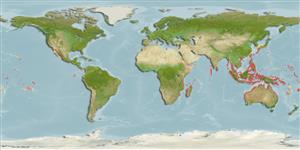Environment: milieu / climate zone / depth range / distribution range
экология
морской; пресноводный; солоноватоводный ассоциированный с рифами; амфидромный (Ref. 46888); пределы глубины 0 - 1 m (Ref. 86942). Tropical
Indo-Pacific: along East African coast, from Zululand in South Africa northwards to the Red Sea and most of West Indian Ocean islands (Ref. 4756); further east to the Marianas and Samoa; north to Ryukyu Islands, south to western Australia and Oceania (Ref. 2334).
Length at first maturity / Size / Вес / Возраст
Maturity: Lm 5.0 range ? - ? cm
Max length : 19.0 cm TL самец/пол неопределен; (Ref. 4756)
колючие лучи спинного плавника (общее число): 12 - 18; членистые (мягкие) лучи спинного плавника (общее число): 9-12; колючие лучи анального плавника 1; членистые (мягкие) лучи анального плавника: 8 - 11. Diagnosis: Distinguished by the following characteristics: pelvic fins lacking frenum; little or no membrane uniting medial most pelvic rays; first dorsal fin height moderate, its margin usually convex, occasionally straight, with a black stripe inframarginally and numerous small, white spots posteriorly on fin, no elongate spines; second dorsal fin with single, dusky stripe mesially; dorsal fins not connected by membrane; first dorsal fin with 11-16 spines; longitudinal scale count 64-100; head width 14.3-22.6% of standard length; pelvic fin length 11.3-15.2% of standard length; length of anal fin base 14.0-19.4% of standard length; length of second dorsal-fin base 17.6-23.7% of standard length; total D2 elements 10-13; total anal fin elements 9-12; TRDB 18-26 (Ref. 5218).
Facultative air-breathing (Ref. 126274); A resident intertidal species with homing behavior (Ref. 32612, 48637) and amphibious air-breather (Ref. 31184, 79840), found in brackish mud flats in mangrove and nipa palm areas. Found in both littoral and estuarine; able to climb out of water, in mangrove swamps and burrowing into intertidal mud banks (Ref. 4756). Occasionally in the lower parts of freshwater streams (Ref. 2847, 44894, 48637, 79840). Actively shuttling back and forth between rock pools and air (Ref. 31184). It feeds on worms, crustaceans, and insects (Ref. 37816). Can stay out of the water for up to 37 h if kept moist (Ref. 51276).
Life cycle and mating behavior
половая зрелость | размножение | нерест | икра | Fecundity | личинки
Murdy, E.O., 1989. A taxonomic revision and cladistic analysis of the oxudercine gobies (Gobiidae: Oxudercinae). Rec. Aust. Mus., Suppl. 11:1-93. (Ref. 5218)
Статус Красного Списка МСОП (Ref. 130435)
Угроза для людей
Harmless
Использование человеком
рыболовство: интереса не представляет; аквариум: коммерческий
дополнительная информация
ссылкиаквакультура (рыбоводство)особенности рыбоводствастепень растяжениягенетикаElectrophoresesнаследуемостьболезниобработкаNutrientsMass conversion
инструменты
Специальные отчеты
Скачать в формате XML
ресурсы в Интернет
Estimates based on models
Preferred temperature (Ref.
123201): 24.2 - 29.3, mean 28.4 °C (based on 2897 cells).
Phylogenetic diversity index (Ref.
82804): PD
50 = 0.5000 [Uniqueness, from 0.5 = low to 2.0 = high].
Bayesian length-weight: a=0.01072 (0.00495 - 0.02318), b=2.97 (2.79 - 3.15), in cm total length, based on LWR estimates for this Genus-body shape (Ref.
93245).
Trophic level (Ref.
69278): 3.3 ±0.40 se; based on food items.
устойчивость к внешним воздействиям (Ref.
120179): высокий, минимальное время удвоения популяции до 15 месяцев (Preliminary K or Fecundity.).
Fishing Vulnerability (Ref.
59153): Low vulnerability (10 of 100).
Nutrients (Ref.
124155): Calcium = 90.6 [43.9, 190.3] mg/100g; Iron = 0.678 [0.320, 1.287] mg/100g; Protein = 19 [17, 21] %; Omega3 = 0.104 [0.045, 0.218] g/100g; Selenium = 11.5 [5.6, 24.8] μg/100g; VitaminA = 115 [29, 427] μg/100g; Zinc = 2 [1, 3] mg/100g (wet weight);
